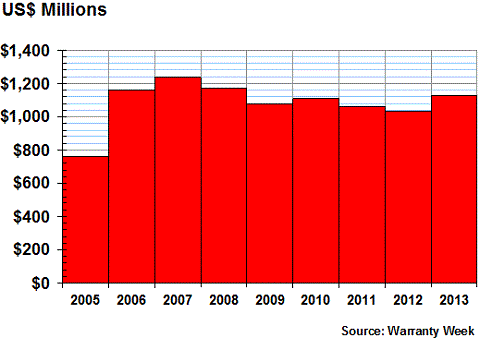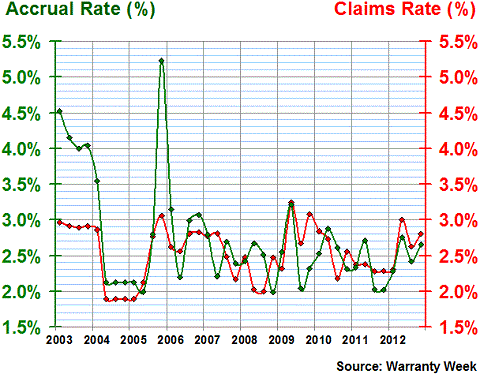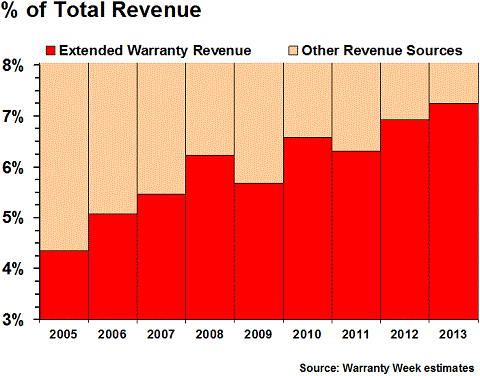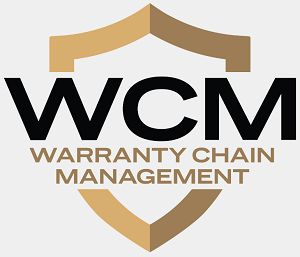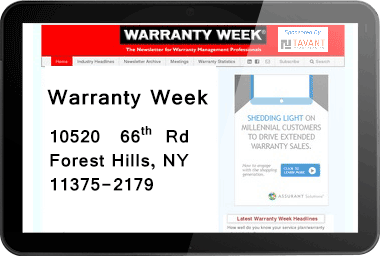January 24, 2013 |

|
ISSN 1550-9214 |
Dell's Extended Warranties:Though its hardware sales have flattened, the importance of Dell's extended warranty program continues to rise. While a few years ago it was twice as large as the product warranty operation, now it's four times larger. And it accounts for a rising percentage of the company's total revenue.Apple Inc. may be the world's largest extended warranty administrator, but the company that paved the way for direct sales of service contracts by computer manufacturers is Dell Inc. Back when Apple was known primarily for its Macintosh family, Dell was dueling with Hewlett-Packard Co. for worldwide market leadership in laptops and desktop computer systems. It was always ahead in extended warranties, however, because Dell controlled the sales channel from end to end while HP usually sold its computers through retailers (who had their own brands of extended warranty to sell). Dell, we reckon, has sold $31.1 billion worth of extended warranties since February 2004, as opposed to the $17.5 billion Apple has sold since October 2003. Dell, an industry veteran with a mature service contract program, has seen its extended warranty revenue grow slowly or fall slightly over the past nine fiscal years. In contrast, Apple has seen its extended warranty revenue rocket upwards since the launch of the iPhone in late 2007. Dell is still the technically revenue leader, but Apple may have taken away that crown in 2012. We'll know for sure in a few months. The companies are on different fiscal year schedules, so direct comparisons are difficult. In the fiscal year ended February 3, 2012, Dell reported $4.3 billion in extended warranty sales revenue, and $1.025 billion in product warranty accruals. In last week's newsletter, Warranty Week estimated that Apple sold $5.3 billion worth of AppleCare contracts in its most recent fiscal year, which ended September 29, 2012. And then in the September 6, 2012 newsletter, we assessed Apple's product warranty expenses, which ended up at $2.184 billion in accruals and $1.786 billion in claims paid last year. In a direct comparison, it's clear that Apple is now the larger of the two, in terms of both product warranty spending and extended warranty selling. Furthermore, because Dell sells primarily direct to consumers while Apple also works with both retailers and telecom carriers (and their extended warranty partners), it's likely that the Apple-branded product universe generates a whole lot more extended warranty revenue for all parties concerned than Dell-branded products do. Dell's Fiscal Year 2013Dell files its next annual report in mid-March, for a fiscal year ending on February 1, 2013. Eight of those 12 months will overlap portions of Apple's most recently completed fiscal year (Feb. 2012 to Sept. 2012). However, so as not to be confusing, we'll adopt a convention in this newsletter of naming the fiscal year by virtue of the calendar year in which it ends. So Apple just completed fiscal 2012, while Dell is about to complete fiscal 2013. For the nine months from February to October, Dell reported only $3.1 billion in extended warranty sales. So we actually expect Dell's extended warranty revenue to fall in the current year, to about $4.1 billion. If that proves to be the case, then Apple's extended warranty sales rate will have definitively passed Dell's sales rate in one of the months of 2012. In last week's newsletter, we reasoned that since most Apple extended warranties last for two years, that half its extended warranty revenue would be classified as non-current at any given point in time. And since Apple publishes annual figures for non-current deferred revenue, we reasoned that doubling that would yield an annual sales total. Fortunately, with Dell, we don't have to guess. The company publishes comprehensive figures for both its product warranties and extended warranties. In the two tables below, which we've taken directly from Dell's annual report for the year ended February 3, 2012, we can see the product warranty and extended warranty figures for each of the last three completed fiscal years. FIGURE 1
DELL'S WARRANTY ACCOUNTS ANNUAL REPORT NOTE 9: WARRANTY LIABILITY AND DEFERRED EXTENDED WARRANTY REVENUE
____________________
In the tables above, the figures for product warranty claims are labeled "Service obligations honored." The figure for product warranty accruals is labeled "Costs accrued for new warranty contracts and changes in estimates for pre-existing warranties." With product warranties, one adds new accruals to the balance at the beginning of the period, subtracts claims paid, and calculates an ending balance. When we calculate a claims rate or an accrual rate, these are the amounts used, along with the corresponding figure for product sales. Extended warranties are a little different. When an extended warranty is first sold, accounting rules specify that the amount collected must be deferred. Then, over time, the company obliged to perform the repairs can recognize the revenue gradually over the life of the contract. Most companies choose to use the straight line method to recognize the revenue. So if it's a three-year contract, they recognize one-third of the revenue each year. Extended Warranty DisclosuresWith extended warranties, one must disclose the amount of deferred revenue, but not much else. As we saw in last week's newsletter, Apple chose to also reveal the amount of that liability which is current (to be recognized as revenue within a year) and non-current (to be recognized more than a year into the future). Dell also includes figures for the current and non-current portions of both its product warranty and extended warranty liabilities. Dell, however, goes a step further and also reveals the amount of new extended warranty sales (labeled as "Revenue deferred for new extended warranties") as well as the amount of past-year sales revenue that has recently been recognized (labeled as "Revenue recognized"). What we don't get is a look at the amount of cost involved in the extended warranties, which would in turn say something about the profitability of these contracts. Product warranties are more or less run as a "break even" operation, where accruals are meant to finance claims with nothing left over. In contrast, extended warranties are supposed to make money in that there will be some money left over once all costs are paid. The profitability of an extended warranty would be the revenue recognized minus the costs, including the largest cost component, which would be claims paid. But there would also be marketing costs, training costs, and other direct and indirect costs. And while we can see how much was paid in claims for product warranties, we would never see the corresponding amount for extended warranties. That amount remains confidential.In other words, the disclosures required for extended warranties are meager, compared to those required for product warranty. For extended warranties, Apple gives us figures for deferred revenue and we have to make guesses about how much of that is extended warranty. Dell gives us figures for extended warranty revenue, but not the cost of repairs. Still, at least in this case, we know there's nothing else mixed in with the extended warranty revenue figure, because in its 2012 annual report, Dell identifies the deferred revenue as extended warranty premiums paid by customers:
Extended Warranty SalesDell's product warranties and service contracts provide a wide array of coverages for different products in different locations. For a $500 desktop sold in the U.S., one year of in-home service and 90 days of telephone support are included for free in the product warranty coverage. A service contract that extends the telephone support to one year is priced at $39. A service contract that extends both in-home service and telephone support for two years is priced at $89. A three-year service contract is $149. A $1150 laptop sold in the U.S. comes standard with a one-year product warranty and one year of telephone support. A service contract that extends the coverage for both to three years is priced at $199 or $6.00 per month. Adding LoJack for Laptops (an anti-theft service) for those three years is an extra $20 or $1.00 more per month. A three-year service contract that also includes accidental damage protection and LoJack for Laptops is priced at $349 or $10.00 per month. Dell Marketing L.P. is the administrator of most of the service contracts. It also self-insures in most areas and acts as the obligor (the company whose duty it is to repair or replace the product) for the product warranties and the basic service contracts. However, for certain tasks or legal obligations, or for certain states or countries, it works with additional partners. For instance, in different U.S. states, the obligors for most of the in-home service contracts are affiliates of The Warranty Group, including National Product Care Co., Service Saver Inc., and the Texas National Product Care Company Inc. In Europe, accidental damage protection contracts are underwritten by London General Insurance Co. Ltd., the European underwriting company for The Warranty Group. Virginia Surety Co. Inc., another affiliate of The Warranty Group, handles accidental damage protection underwriting in Australia. For the Optiplex, Precision and Dimension computer systems, across most of Europe, Dell sells service contracts that provide next business day on-site service. The list of these countries, which the company defines as its "Dell direct country" region, includes Austria, Belgium, the Czech Republic, Denmark, Finland, France, Germany, Greece, Ireland, Italy, Luxembourg, Netherlands, Norway, Poland, Portugal, South Africa, Spain, Sweden, Switzerland, and the UK. In Canada, for the Dimension product line, Dell Canada Inc. contracts for on-site and next business day repairs with Getronics Canada Inc., a unit of the Aurelius Group. On-site and next business day repairs for most other products are administered by Dell itself. Worldwide, Dell reported product warranty claims of $1.032 billion in the fiscal year ended February 3, 2012, down slightly from the $1.063 billion reported in the previous fiscal year. Based on nine-month figures, we expect the current fiscal year's claims total to come in a little above $1.1 billion. Product Warranty Claims PaidFigure 2 charts the amounts Dell provides each year for "Service obligations honored," otherwise known as warranty claims. As the data shows, Dell's annual product warranty claims payments peaked in the year ended February 2, 2007, at a level of $1.235 billion. The following fiscal year, claims costs fell to $1.17 billion, even though product revenue rose. Figure 2 |
|||||||||||||||||||||||||||||||||||||||||||||||||||||||||||||||||||||||||||||||||||||||||||||||||||||||||||||||||||||||||||||||||||||||||||||||||||||||||||||||||||||||||||||||||||||||||||||||||||||||||||||||||||||||||||||||||||||||||||||||||||||||||||||||||||||||||||||||||||||||||||||||||||||||||||||||||||||||||||||||||||||||||||||
| |||||||||||||||||||||||||||||||||||||||||||||||||||||||||||||||||||||||||||||||||||||||||||||||||||||||||||||||||||||||||||||||||||||||||||||||||||||||||||||||||||||||||||||||||||||||||||||||||||||||||||||||||||||||||||||||||||||||||||||||||||||||||||||||||||||||||||||||||||||||||||||||||||||||||||||||||||||||||||||||||||||||||||||


